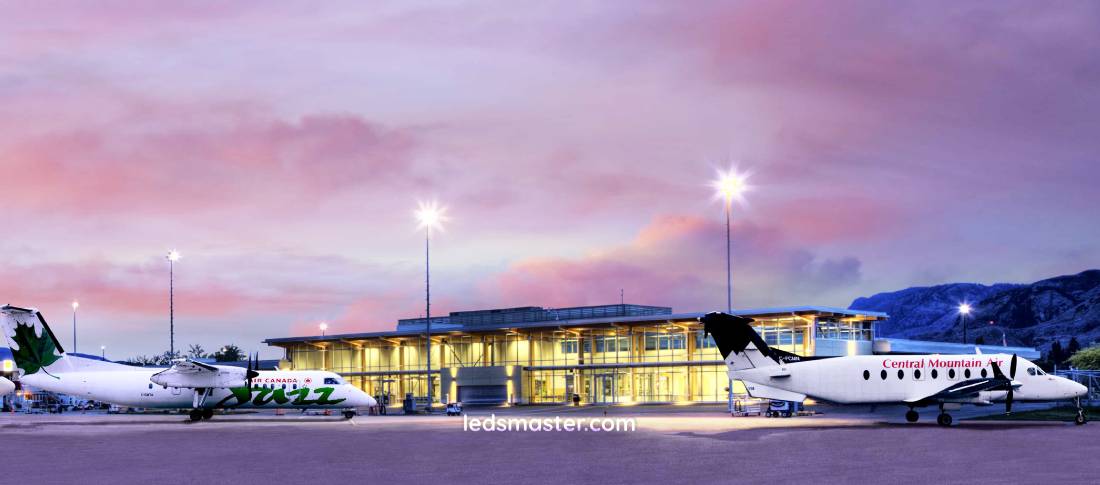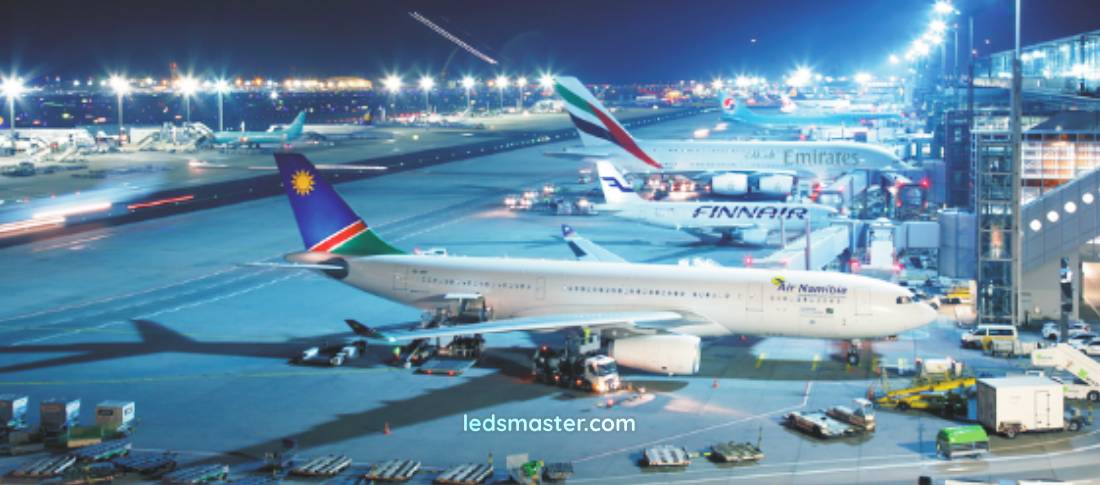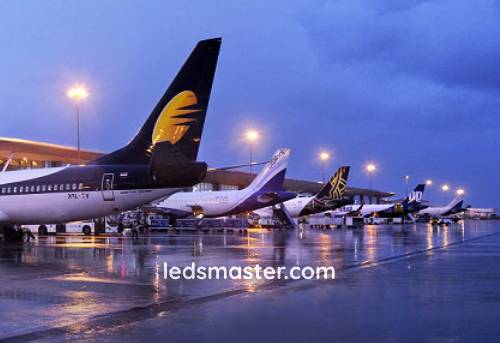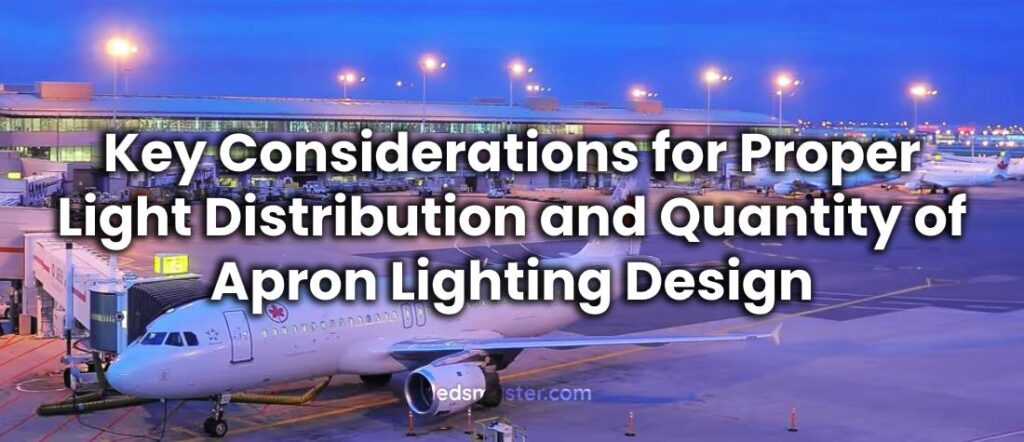Lighting on an airport apron is integral to ensuring that operations are performed safely and efficiently. The apron is the area where aircraft are parked, loaded, unloaded, and serviced, and it is essential for visibility during both day and night operations. Proper lighting in this environment enhances safety for ground crew, pilots, and passengers, helping prevent accidents, ensuring aircraft are maneuvered correctly, and providing clear visibility for all personnel. The design of apron lighting involves careful consideration of how many lights are needed, as well as how they are distributed across the area. Getting both aspects right is crucial for achieving uniform illumination and meeting regulatory standards.
Table of Contents
ToggleFactors Affecting the Number of Lights

Several elements shape the total count of fixtures required to light an apron effectively. Beyond the obvious measures of area and activity, considerations such as environmental conditions, mounting height, and ground surface characteristics also play a role in determining how many lights are called for. A holistic evaluation of these elements ensures that every section of the apron receives adequate illumination without creating areas of glare or shadow.
Environmental factors, such as local weather patterns and seasonal variations, can influence light performance. In regions prone to fog or heavy rainfall, higher intensity fixtures or a greater number of lights may be called for to penetrate moisture and maintain visibility. Conversely, in arid climates with clear skies, designers can often achieve the desired illuminance with fewer fixtures.
The height at which lights are mounted also affects their coverage footprint. Taller poles allow a single fixture to cast light over a broader area, reducing the overall number of fixtures needed. However, as mounting height increases, designers must account for beam angle and spill light to avoid bright spots or dark edges. Striking the right balance between height and beam spread can optimize the number of fixtures required.
The reflectance properties of apron surfaces—such as concrete, asphalt, or specialized coatings—affect how light is scattered and absorbed. Surfaces with higher reflectivity can help distribute light more evenly, potentially reducing the count of fixtures needed. Areas with darker or worn surfaces may demand additional lighting to compensate for light loss.
Area Size
The total square footage of the apron directly correlates with fixture quantity. A sprawling apron that accommodates multiple wide-body aircraft and service lanes requires a greater number of fixtures to guarantee full coverage. Irregular shapes or extensions for cargo handling and maintenance bays introduce zones that can become underlit if not carefully planned.
Zones with heavy equipment movement, such as tow paths and refueling stations, often warrant dedicated lighting clusters to avoid creating shadows where workers and vehicles intersect. Mapping these high-use corridors against the overall apron layout helps in spacing fixtures to achieve a balanced light distribution across the entire surface.
In smaller aprons, designers can group lights more closely, but must remain mindful of overlap to prevent bright patches. Even with fewer fixtures, strategic placement is required to maintain a uniform spread, avoiding the illusion of darker pockets that could hamper operations.
Activity Level
The frequency and nature of ground operations dictate the intensity and number of lights. Aprons serving international flights with rapid turnarounds and night schedules need more fixtures to support continuous activity. Each additional gate or service position introduces another focal point requiring reliable illumination.
Specialized tasks such as engine maintenance, cargo loading, and aircraft inspections demand localized lighting that may be switched on independently of general apron lights. Integrating these task-specific fixtures into the overall count ensures that workers have ample light where and when they need it, without overloading the general lighting grid.
Emergency scenarios, like unplanned repairs or medical evacuations, call for a baseline of high visibility at all hours. Airports that operate around the clock often adopt a higher fixture density to accommodate shift changes and peak activity periods without compromising safety.
Regulatory Standards

Aviation authorities provide guidelines on minimum illuminance levels, uniformity ratios, and fixture positioning. For instance, Annex 14 of the International Civil Aviation Organization outlines recommended lux levels for different apron zones and mandates how even the light distribution must be. Designers refer to these documents to determine both the number of lights and their spacing to meet or exceed regulatory thresholds.
Local aviation bodies may impose additional criteria, such as limits on light spill beyond airport boundaries or specifications for fixture types and energy efficiency. Compliance with these mandates often involves photometric modeling to simulate light distribution, ensuring the final design adheres to all legal and operational requirements.
Documentation of the lighting plan, including as-built photometric reports and maintenance schedules, forms part of the compliance process. Keeping these records up to date helps airport operators demonstrate adherence to regulations and supports future audits or expansions.
Consequences of Too Few Lights
 When an apron is underlit, a range of operational challenges can arise that affect safety, efficiency, and cost. Dim or uneven illumination creates pockets of poor visibility where hazards may go unnoticed. Ground personnel, pilots, and maintenance crews all depend on clear sightlines to perform tasks with precision. Without enough light, even routine operations can become fraught with risk, leading to errors, delays, and potential damage to aircraft or equipment.
When an apron is underlit, a range of operational challenges can arise that affect safety, efficiency, and cost. Dim or uneven illumination creates pockets of poor visibility where hazards may go unnoticed. Ground personnel, pilots, and maintenance crews all depend on clear sightlines to perform tasks with precision. Without enough light, even routine operations can become fraught with risk, leading to errors, delays, and potential damage to aircraft or equipment.
Reduced Safety
Poorly illuminated areas on the apron increase the likelihood of accidents involving both people and machinery. Ground crew members may struggle to see guiding lines, equipment markings, or each other’s movements, raising the risk of collisions with baggage carts, fuel trucks, or aircraft. Pilots taxiing in low light may miss obstacles or misjudge distances, potentially causing contact with ground vehicles or other aircraft. In the event of an emergency, responders need unobstructed visibility to act quickly; inadequate lighting can slow their response and endanger lives.
Operational Delays
Insufficient lighting forces personnel to work more slowly and cautiously, extending the time required for tasks such as loading cargo, refueling, or towing aircraft. Each additional minute spent waiting for better visibility can cascade into longer ground times and missed departure slots. When night operations are involved, flights may be held at the gate or rerouted to better-lit aprons, disrupting schedules and inconveniencing passengers. Over time, these delays can erode an airport’s reputation for punctuality.
Equipment and Infrastructure Damage
Dim lighting makes it harder to spot obstacles or gauge clearances, leading to accidental scrapes, dents, or more severe impacts. Tow tractors may veer too close to jet engines, service vehicles can collide with ground support equipment, and tools left on the tarmac can go unnoticed until they cause tire damage. Repairing these incidents incurs both direct costs and downtime, as vehicles or sections of the apron may need to be taken out of service for maintenance.
Regulatory Penalties
Aviation authorities mandate minimum illumination levels for different apron zones. Falling below these thresholds can trigger fines, operational restrictions, or even temporary shutdowns until lighting upgrades are completed. Regular inspections verify that lighting remains within the prescribed parameters; failure to maintain adequate levels can result in citations or increased scrutiny during safety audits. Airports that neglect their lighting obligations may face reputational harm alongside financial penalties.
Increased Operational Costs
Beyond the expenses associated with accidents and penalties, underlighting drives up labor costs as crews take longer to complete tasks. Overtime may be required to make up for lost time, and additional training might be needed to ensure staff can work safely under suboptimal conditions. Insurance premiums can rise after repeated incidents attributed to poor visibility. When all these factors are combined, the cost of operating an underlit apron often exceeds the investment needed to install the correct number of fixtures.
Consequences of Too Many Lights
On the other hand, over-illumination can also create problems. Installing too many lights on an apron can result in excessive brightness and glare, leading to discomfort for ground personnel and pilots. Over-illumination is a waste of energy and resources, driving up operational costs unnecessarily. Moreover, too many lights can create light pollution, disrupting nearby areas or affecting the natural environment. It is important to find the right balance to provide adequate visibility without overdoing it.
Energy Waste and Cost Implications
One of the key issues with installing too many lights is the significant energy consumption. Each additional light contributes to the overall electricity demand, which increases operational costs for the airport. This also results in a higher environmental impact, as more energy consumption means a greater carbon footprint. Airports aiming to reduce their environmental impact must carefully consider the number of lights they install to avoid unnecessary energy waste and its associated costs.
Glare and Discomfort
Excessive lighting can lead to glare, which can be uncomfortable or even dangerous for personnel working on the apron. Strong light sources can impair vision, especially during nighttime operations, making it harder for ground crew to see clearly. Additionally, pilots may experience difficulty navigating aircraft on the apron if their line of sight is blocked by bright, overly intense lighting. Striking a balance in light levels is essential to minimize glare while ensuring sufficient illumination for safety.
Environmental Impact
Over-illumination also contributes to light pollution, which can have adverse effects on the surrounding environment. For instance, excess lighting can disrupt wildlife and interfere with natural ecosystems. In the context of an airport, light spillover can affect nearby residential areas, leading to disturbances for local communities. Airports need to consider not just the quantity of lights but also how they manage light distribution to avoid excessive environmental impact.
Light Distribution and Uniformity
Even when the correct number of lights is used, poor distribution can lead to uneven lighting across the apron. Uneven illumination can create shadows or overly bright areas that compromise safety and efficiency. For instance, certain sections of the apron may be overlit while others are poorly lit, creating unnecessary risks. To achieve effective apron lighting design, a uniform distribution of light is essential, ensuring that every part of the apron receives the same level of visibility.
Planning the Layout
When planning the layout of lighting fixtures, it is important to consider the shape and size of the apron. Proper placement of lights ensures that all areas are evenly illuminated. In some cases, apron layouts may include certain obstacles, such as aircraft or ground service equipment, that require strategic positioning of lights to avoid shadows. Using light poles with adjustable angles or floodlights that can be directed precisely where they are needed can help achieve better light distribution across the area.
Lighting Technology
The type of lighting technology used can also affect light distribution. LED lights, for instance, are more energy-efficient and provide better control over light spread. These lights can be positioned and angled precisely to minimize light spillover while ensuring optimal coverage. With advanced lighting technology, designers can fine-tune the intensity and spread of light to achieve uniform illumination without wasting energy or causing glare.
Regulatory Compliance in Apron Lighting Design
Meeting regulatory standards is another fundamental aspect of apron lighting design. Aviation authorities establish guidelines that help ensure safety and efficiency. These standards outline the minimum lighting levels required for different apron sections, the positioning of lights, and the types of fixtures to be used. Compliance with these regulations is not only necessary for safety but also for preventing legal issues and maintaining smooth airport operations. Designers must carefully study and implement the regulations governing apron lighting to avoid potential penalties and ensure the apron is adequately lit for all activities.
Conclusion
Designing the correct apron lighting requires a delicate balance between the number of lights, their placement, and the quality of light distribution. Too few lights can cause visibility problems, which in turn can lead to safety risks and operational delays. On the other hand, excessive lighting may cause energy waste, glare, and environmental concerns. By considering factors such as apron size, activity level, and regulatory requirements, airport authorities can determine the right number of lights to install. Proper distribution is just as important, ensuring uniform lighting across the apron area. As airports grow and technology evolves, lighting designs must adapt to ensure safe, efficient, and sustainable operations.

